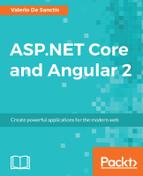Book Description
Create powerful applications for the modern web
About This Book
- Build a complete single page application with two of the most impressive frameworks in modern development
- Find out how to bring together the capabilities and features of both Angular 2 and ASP.NET Core
- From managing data, to application design, through to SEO optimization and security ? take a comprehensive approach to building your next web project
Who This Book Is For
ASP.NET developers ? find out how to bring Angular 2 into your development stack and extend your skillset so you can build even better single page applications.
What You Will Learn
- Find out how ASP.NET Core's and Angular 2's features perfectly complement each other
- Learn how to set up the resources you need and configure the MVC 6 interface
- Handle requests and actions using server-side and client-side Routing
- Create the Data Model using Entity Framework Core
- Learn how to use Angular 2 components and master directives
- Implement a token-based authorization and authentication flow supporting external login providers such as Facebook, Google, Twitter and more
- Create responsive, mobile-friendly views using Bootstrap and LESS
- Setup and optimize your production environment using IIS and SQL Server
- Secure your application against a diverse range of dangerous security threats
In Detail
Writing code is about striking a balance between maintainability and productivity - how quickly you can write it against how much more you have to write in the future. This is a guide to doing just that by combining the impressive capabilities of ASP.NET Core and Angular 2. It shows you how to successfully manage an API and use it to support and power a dynamic single-page application.
We'll show you how to construct your data model and manage routing and redirects before wrapping it up and styling it, all with the help of ASP.NET and Angular 2. You'll also learn how to optimize your application for SEO, check and secure any vulnerabilities, implement a viable authentication mechanism and, last but not least, use the proper tools and strategies for successful deployment. From readable URIs to OData retrieval and authentication patterns, we'll make sure you have all the technical knowledge you need and, more importantly, bring it all together so you can focus on what's important: a high-quality application that performs for users.
Style and approach
More than just a technical manual, this guide takes you through the most important technical facets of developing with these two hugely popular frameworks and then demonstrates how to put those skills into practice. It's a book that recognizes that what's really important is the end product.
